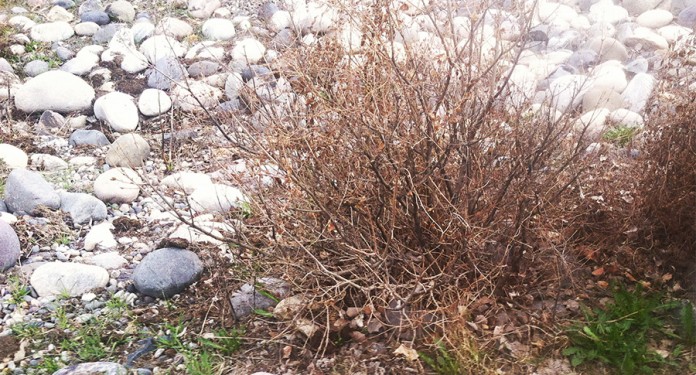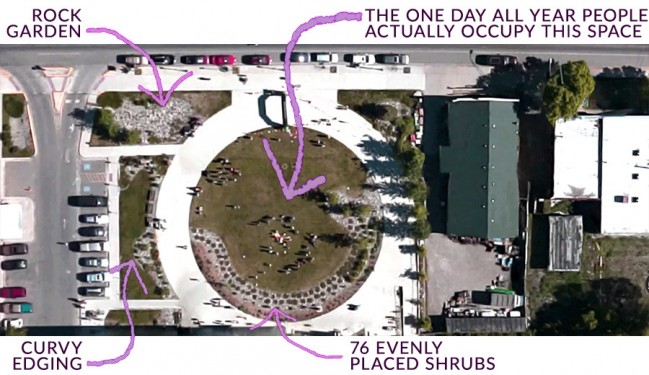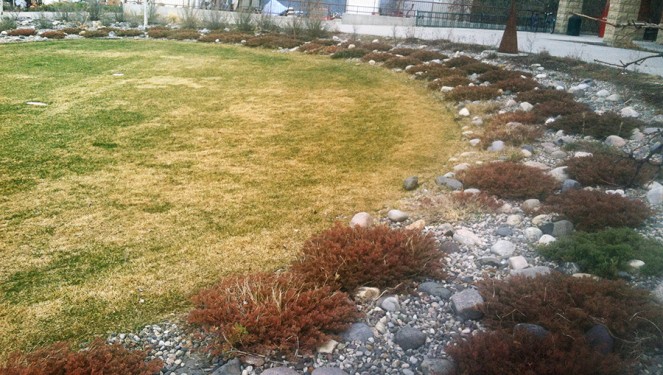
Wait! What is the opposite of potency? Impotence? Then that is what I meant.
Landscape Architects are the worst. And by extension, landscape designers, or homeowners that pretend to be landscape architects are the worst.
I had a friend who rented a skid-steer loader1 to “improve” the landscaping around his house. He then proceeded to get several yards, or bucket loads, of Herculean sized gravel (between 4” upwards to 10”). He then dumped his wonderful “gravel” within an artificially created 36” buffer between his house and his un-manicured lawn. I assumed this would be an all-day activity, but then he strategically placed a few bric-a-brac items (namely concrete animals and wooden signs of rabbits holding smaller wooden signs stating, “welcome”) and exclaimed, “All done!”
Now, this is someone who had no grass, and thought if he placed a dried riverbed next to his abode, it would make things more attractive than just planting grass.3 His “landscaping” was pretty bad, but the only thing he could have done worse would have been to plant three potentillas, evenly spaced, within the confines of his gravel quarry.
Indeed, the absolute worst landscaping shrub is the potentilla.
-Genesis: Numeral colon numeral number comma numeral“On the third day God created, plants, vegetation, and trees; and God saw that it was good. On the fourth day God turned his back, and up sprung noxious weeds and potentillas.”
Potentillas are a small shrub in the rose bush family. They do not grow very tall, nor do they branch out very wide, yet they are always planted with enough potential girth between plants to allow for a small Sequoia tree. In addition, potentillas are unique in that they exist in a quasi-purgatory world, attempting to be both a biennial and a perennial: thus constantly existing in a state of looking half-dead.4
The main problem with potentillas as a landscaping “feature” is that they produce small flowers, but hardly anyone ever takes the time to prune these insignificant shrubs; thus their small woody stalks remain exposed throughout the entire year. If you do not know what a potentilla looks like, imagine driving through Wyoming and seeing tumbleweed blowing across the road; that is actually a run-away potentilla in seek of ruining another landscape design.
I worked for a landscape company that thought potentillas were the greatest urban decoration since parking meters. The owner didn’t have any design background, but he also operated a greenhouse overrun with potentillas.5
Thus, the ideal landscaping design became: equally space potentillas within a barren bed of rainbow rock or wood chips, and have black plastic edging gently flow in a curvilinear fashion to dignify it as a “natural landscape”. However, placing potentillas an equal spacing apart following a sidewalk are the epitome of unnatural. If you have a symmetrical building, a symmetrical yard, a symmetrical sidewalk, bordering a symmetrical street, a slightly curving landscaping bed against your house does not make it look native nor natural.

Landscape architects need to take notes from architects, and limit their material palette. Sure, an architect could design a facade with every material they know, but it is always better to limit the material palette to three materials, or even just one, designed in a complementary fashion. If landscape architects eliminated all plants/grasses/shrubs to two or three, and used more of these select plants the landscaping plans would dramatically improve.
There are probably millions of residential landscaping plans I could critique, but when atrocious landscaping flows into the urban fabric it diminishes all of society. Thus, the Bozeman Public Library should be a University Studies course in how to design ugly and useless spaces. Also, the library sits across the street from my firm’s former office, and is located across from a local bar; thereby providing hours of un-insightful insipid thoughts while staring at potentillas.
The Bozeman Public Library landscaping plan looks alright as an aerial view, but when experienced, everyone goes, “Ooh, this is a lot of useless space. I think we made a mistake.”
Here is an aerial view of the Bozeman Public Library in Eames’ Power of 10 Style (but in reverse):


The library is located on the end of Main Street adjacent to Lindley Park. However, in revolting from, the seemingly rational, idea of being associated with the Main Street buildings situated upon the sidewalk, the library planners moved the building away from the street6 and created a gigantic circle of grass flanked by a sidewalk. Apparently, this grassy expanse was intended to be flooded in the winter and used as a diminutive ice skating rink, but it remains just a devoid pit that gets limited foot traffic due to the lengthy excursion one must take just to enter the library from Main Street.
Actually, this circle of grass might be a nice reading area if not completely exposed to the street. If only there was a giant park bordering the property that they could incorporate an adjacent outdoor reading area. Oh wait, there is! The library abuts Lindley Park, and this landscape feature would be a nice tranquil space with direct access to the park, but by fronting the street, it becomes unnerving for patrons to hang out here, or even walk through.7
The building qualified for LEED Silver status, and boasted about having 500% more open space than required by the city. There should be a retroactive revisit of LEED credits, because uncomfortable vacant spaces should qualify for a reduction in LEED credits!8

Furthermore, just a sampling of the grasses and plants within the premises of the library include: Canada Bluegrass, Little Bluegrass, Wheatgrass, Ryegrass, tall Fescue, Garden Phlox, Hosta, Day Lily, Lupine, Coneflower, Yarrow, Hollyhock, Stonecrop, Speedwell, and Dianthus.
Please, landscape architects! I am sure you can detail the pinnations in a maple leaf, and can name 93 perennial shrubs in the Rosaceae family; but there is no need to show off by incorporating all 93 plants into every project.
Footnotes:
Click the purple numerals to transport between hyperlinks
1 I worked landscaping jobs for years, and my amazing soon-to-be wife is still a landscaper, and apparently if it is not Bobcat brand, you cannot call all skid-steers Bobcats. 2
2 Yeah, that’s right! I footnoted a footnote… I am only friends with other architects, yet I wonder if people in the medical field freak out if you use the term band-aid when referring to an adhesive bandage.
3 I am not against native landscaping, but if you already are going to waste natural resources then you should make it look good.
4 No. I am not a horticulturist.
5 My amazing soon-to-be wife (not even girlfriend at the time) and I spent many inclement weather days inside the greenhouse pruning these trifling plants.
6 Think Mies van der Rohe’s Seagram Building, yet unsuccessfully accomplished.
7 From our old office we once saw a couple attempting to cross-country ski across this area, but other than that I think more people have walked on the moon than crossed this expanse to enter the library.
8 LEED has good intentions, but if aesthetics or user experience are not taken into account, then how does LEED actually improve the experience of the built environment, beyond just being a recycling program, or a way for a city to brag about how their buildings are saving the world.


Hi Brady, nice article!
I agree that the landscape design in those photos looks dreadful. I can’t believe that arrangement of mini-shrubs around the circular green was considered by anyone other than a lazy gardener appointed by the state to plant a certain number of plants in a given time, and didn’t want to get their footwear muddy, so placed them all within reaching distance of the walkway.
But I think it’s unfair to say that all landscape designers are bad, based on this one dire example. You must have worked with some good ones. I have met and worked with knowledgeable, passionate and conscientious landscape architects, whose designs complement and engage with the encompassing architecture.
Also, let’s not pretend it’s the landscape architect’s fault that the building was set back so far from the road. I guarantee they were brought on board long after that decision was made, to fill in the gaps made by the Architects. Not all Architects are that great either…
Dan,
You are correct. The architects had the conscientious decision to place the building set-back from the street. And this shouldn’t be blamed on the landscape architects.
A little back-story: the architectural firm is based out of Texas, and apparently it is fairly common for civic buildings in Texas to be set-back off the street, creating small courtyards.
But this isn’t Texas, thus I should’nt blame the landscape architects for poor urban planning principles. However, the landscape architects did further propagate poor design strategies. They could have created a barrier with trees or larger hedges to create a more intimate area, but instead they planted drought tolerant plants to emphasize the vacant circle of grass.
And Yes. I have worked with many amazing Landscape Designers. And while I have worked with several mediocre Landscape Architects, I agree, I shouldn’t lump them all into one ball, and throw them under the bus altogether…
…just some of them. Haha
I once worked in a large practice which included a small team of landscape architects. They were concerned about how they were perceived within the practice, so sent out a memo asking colleagues simple questions like “what do you think we do?”
Unfortunately for them, the overwhelming response was “trees and shrubs”. Whilst this might have been a tongue-in-cheek response from a bunch of naughty Architects, there is a serious side to this; the one area where we expect landscape architects to ‘get it right’, is in their selection of trees and shrubs. In your example they have clearly got it wrong. They have let the side down!